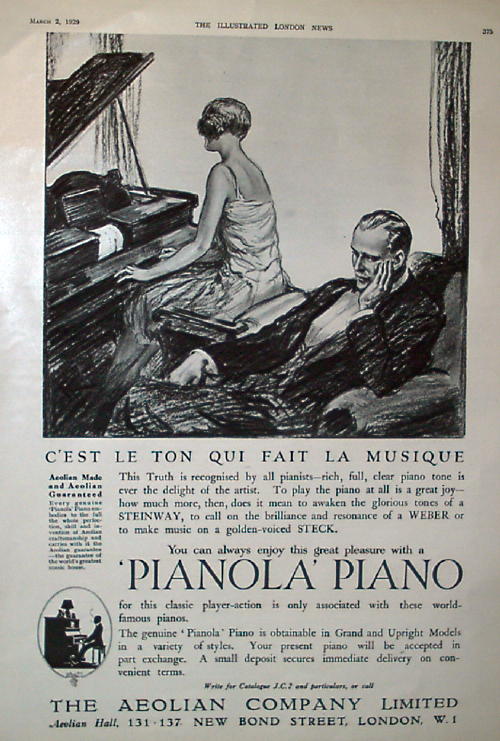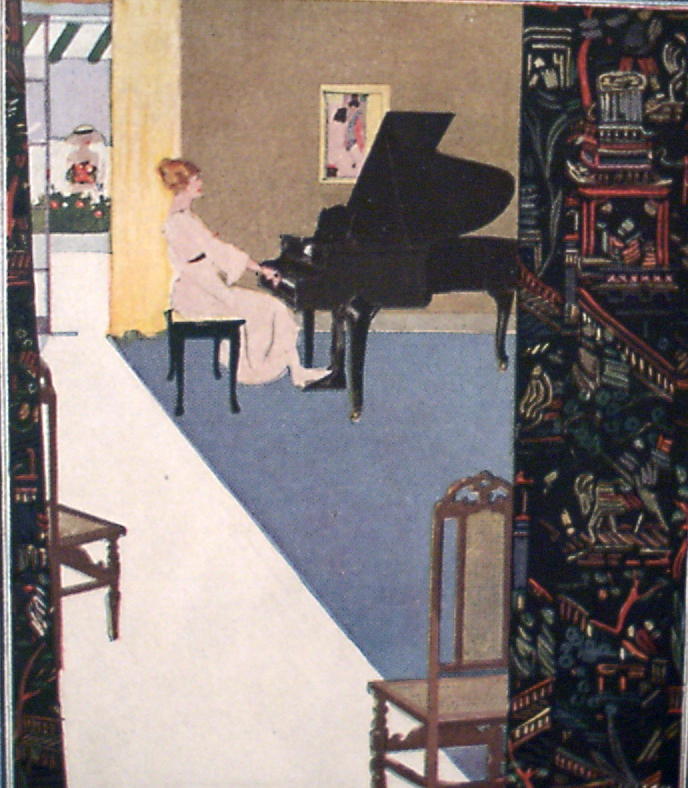
Below, we present an image of the Saturday Evening Post advertisement featuring the "finishing school" society girl, BETTY and her friends, plus DADDY DEAR and the ghost of MUMSIE, who was the crowning level of hack marketing methods, used by Aeolian in 1920. (It's obvious that BETTY lives on Park Avenue, Riverside Drive or perhaps Fifth Avenue, since she can "pop into Aeolian Hall on a whim, after taking in a Broadway show ... and then enjoy Josef Hofmann, live, at Carnegie Hall — all on the same weekend!
[Poor BETTY, for she went to a ho-hum show called "Buddies" when it could have been "La, La, Lucille" by the young George Gershwin ... or something with better music by Jerome Kern. She blew her Broadway experience! Had they attended the Gerswhin musical, she could have enjoyed FAKE-Gershwin rolls afterwards, including #10023 TEE-OODLE-UM-BUM-BO from "La, La, Lucille", a catchy number arranged by Rudolph Erlebach, who also arranged the "played by Gershwin" roll of SWANEE from "Sinbad" (#1649), a year later.]
The text of the following Post ad is reprinted in full on this companion Web page: http://www.wiscasset.net/artcraft/mumsie.htm ... and if you enjoy this unintentionally hilarious text, you might consider our ARTCRAFT Roll called BLISSFUL TRYST, The Saga of André and Lila. (This 88-Note Word Roll, with a maudlin story attributed to Lee S. Roberts, can be found on the ARTCRAFT Website: http://www.wiscasset.net/artcraft/rolls3.htm ... and scroll down to "blissful", with "b" as in "barf".)
Here's the picture of the Aeolian text for the "Mumsie" story!

We can't top BETTY for a sickening letter to DADDY DEAR. Incidentally, BETTY is talking about her social rival's six-legged Duo-Art grand piano, but the picture, above, shows an upright with a chair that's conveniently blocking the fact that it might have pedals, since Aeolian often used their lithographs for both kinds of instruments.. Does BETTY want an upright for her Easter Holiday ... or is she just spaced out? Who knows? Why is that Metrostyle Pointer in a vertical position, since it wouldn't be needed for FAKE-artist rolls? (We've got many questions but no answers, here.)
The next two illustrated ads feature Aeolian and Angelus using "distorted" drawings of the players, for the purpose of attracting customers. Clearly, the purveyors of expensive players felt a need to reduce the size of the hand controls, or cover them with shadows entirely. (Years earlier, Aeolian in the States had the 'external pump' grand piano models in their ads, often in a mansion entrance, and with two Russian wolfhounds blocking one's view of that LARGE CABINET which encased the electric motor and the oversized six-exhauster Duo-Art pump. Dogs with Duo-Art players? Yes ... until the built-in rotary pumps were installed under the sounding board, when the later designs came long!)

Beyond the fact that the man in the picture, above, appears to be totally bored (or is nursing a toothache), note that the drawing obscures any visual references to the FOOT PEDALS on this English Pianola Piano. Again, the Metrostyle Pointer is erect, but her fingers are poised over a shadowy part of the instrument, so fuzzy that the keyslip controls aren't seen. The 1929 ad is doubly unusual in that Aeolian Ltd. in England was bankrupt, and about to be sold off to Harrods department store ... or perhaps had been when The Illustrated London News ran this display in Spring of that year. The Duo-Art player isn't mentioned. Could Harrods have decided, with the Colonial buyers ordering from them, that pedals were easier for export than fussing with a variety of voltages and AC/DC currents? To their credit, British Aeolian stressed the piano tone for the "glorious" Steinway, the "golden-voiced" Steck and the "resonant" Weber. You get the impression that the piano as a keyboard instrument is as important as the player action ... for indeed it is!
In 1919, the Wilcox & White Co. of Meriden, Connectict ran the following illustrated advertisement ... one, which when examined by any standard of comparison, is vague at best and hardly motivating.
(Actually, Aeolian's factory in Meriden, Universal Music Rolls, duplicated their 58-Note as well as the Artistyle 65 and 88-Note rolls for the Angelus players, but the 'hand played' Masters were indeed created by the musicians at Wilcox & White: Percival Van Yorx and Russell H. White, the latter a personal friend of mine all through the 'Fifties, and still living in Meriden at the time. The 'Voltem' 88-Note and the 'Artrio-Angelus' expression rolls were either adapted from German Welte-Mignon arrangements ... or 'recorded' in their Studio and then arranged after-the-fact, for Aeolian's bulk duplicating. Later, QRS took over the 'Artrio' rolls, now renamed 'Angelus' by the Simplex Co., in Worcester, Mass., which absorbed the family-operated enterprise in 1921.)

We see a lady in a posh interior, enjoying her unnamed grand piano ... but is it a player (and what brand)? Angelus made pedal players for grand pianos, pedal-electric 88-Note player actions and the electrically-pumped 'reproducing' Artrio style, mentioned in the paragraph above. (Perhaps some magazine readers thought to themselves, "I'll just skip the Emerson Angelus for now and buy some furniture, a carpet, draperies and perhaps a larger residence ... and then, if any money is left over, might consider a Player-Piano.) References to their highly artistic 'Diaphragm Pneumatics' abound in this text, along with the word "science", but they are not defined for the magazine reader. Basically, it's just a lady at a grand piano — postioned in an elegant decor — supported by affected puffery for the text, saying little about WHAT the instrument really is. "It frees the spirit" was the thrust. However, most people wouldn't even notice that the grand had a player roll above the keyboard, and in the dim lighting of that day, might even asume that the maiden was playing upon the keys (which pretty much negates the premise of having the Angelus action installed, doesn't it?).

Luckily for you, the reader, we enlarged the miniature Angelus illustration so that you can see a snippet of the music roll above the keyboard. It's not clearly shown whether the lady has her hands on the keys or the Angelus controls, but the FOOT PEDALS are almost invisible in this picture! Angelus uprights had pedals which opened and closed automatically, in this late period. The Angelus grand pianos had pedals which opened automatically, but the Pianolist had to bend over to fold them away when converting back to a standard keyboard piano. (Note: It's easy to have the pedal assembly on the grand piano come crashing down on one's feet, since they "thud" to the floor, when the keyslip is opened for the Angelus controls. By contrast, the uprights had a pneumatic to act as a brake when they opened ... and a spring action for the automatic closing of them when converting back to a keyboard instrument.)
Our museum, The Musical Wonder House, has a Brinsmead (English) Angelus grand ... and the pedal assembly is considerably LARGER than what one sees in that picture of 1919. Moreover, Angelus grands had 2 long, and highly visible, wooden "push rods" that connected to the exhausters under the sounding board; these 'destroy' the piano's profile by coming up from the sustaining pedal area at a 45 degree angle. It would be easy to assume that the lady in this picture was using the electric version of the Angelus player, but the extension cord (always shown then - even in vacuum cleaner ads) isn't visible! Even so, somebody "miniaturized" the Angelus pedal unit, definitely!
Home Page for
ARTCRAFT
Music Rolls
Wiscasset, Maine 04578 USA
Telephone: (207) 882-7420
Send an E-Mail message to ARTCRAFT
Rolls